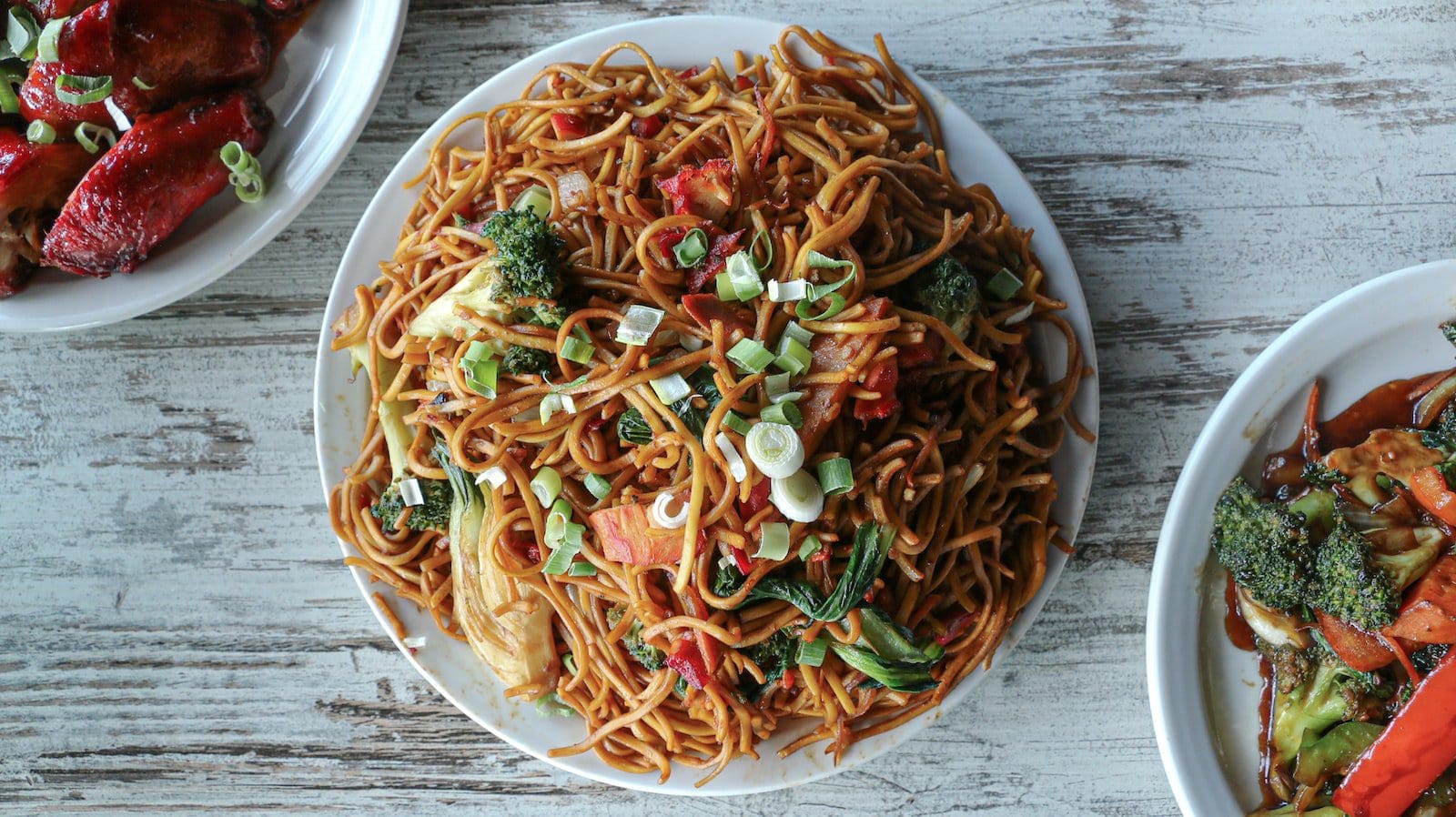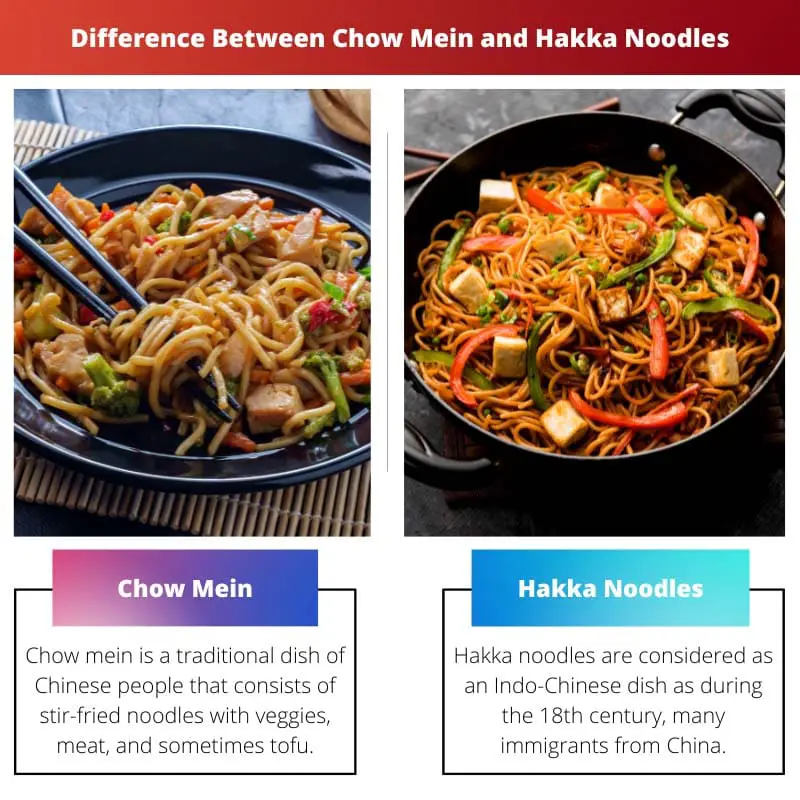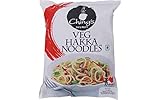No one can ever deny that everyone loves tasty and glossy noodles be it Hakka noodles or chow mein, but have you ever wondered what makes these noodles different from each other.
People love eating these noodles without knowing the difference between them and assuming they are the same dish. They indeed are originated from China, but many factors make them unique.
Key Takeaways
- Chow Mein is a Chinese dish with stir-fried noodles, vegetables, and meat or seafood.
- Hakka Noodles are an Indo-Chinese dish with boiled noodles, vegetables, and sauces.
- Chow Mein is stir-fried with high heat, while Hakka Noodles are boiled and then stir-fried.
Chow Mein v/s Hakka Noodles
The difference between Chow mein and Hakka noodles is that chow mein is a type of noodles made by the people of the Taishanese community living in the Guangdong part of China. On the other hand, Hakka noodles are the style of noodles prepared by the Hakka Chinese people living in the Sichuan, Hunan, Jiangxi, Guangxi, Fujin, and Guangdong areas of China.

Chow mein is a traditional dish of Chinese people that consists of stir-fried noodles with veggies, meat, and sometimes tofu. There were many variations seen in the traditional chow mein recipe depending upon the regions of China.
People sometimes fry the noodles or sometimes boil them. Chow mein was introduced to the world by the immigrants of China and quickly became popular in most Chinese restaurants abroad.
On the other hand, Hakka noodles are considered as an Indo-Chinese dish as during the 18th century, many immigrants from China, mainly the Hakka Chinese population came to India and settled down in the Tangra region.
Their cooking style was influenced and combined with the Bengali culture of Kolkata which gave birth to Hakka Noodles.
Comparison Table
| Parameters of Comparison | Chow Mein | Hakka Noodles |
|---|---|---|
| Belongs to | Taishanese community | Hakka community |
| Cooking style | Stir-fried | Tossed and stir-fried |
| Protein per serving | 3.77 g | 11 g |
| Calories per serving | 237 | 290 |
| Texture | Crispy | Soft and silky |
What is Chow Mein?
Chow mein is a traditional dish of China that has stir-fried noodles made with some vegetables, meat, and tofu. Variations in the traditional recipe and the toppings of chow mein have been seen over the years.
The Chinese population who migrated to overseas countries introduced chow mein to that country. Chow mein is very famous among all the Chinese immigrants and this dish appears in almost every Chinese restaurant in foreign countries.
In the countries like India, Nepal, the UK, and the US, chow mein is very popular and eaten by most of the population. The word chow mein is the American modified word by the traditional Chinese word Chao min.
The pronunciation of the word Chaomin came from its Cantonese pronunciation, and the word Chao min was introduced to the English people in the year 1906. The meaning of this word is stir-fried noodles and the English translation is fried noodles.
The people of California, USA came to know about chow mein when the immigrants arrived from China along with their Cantonese style of cooking.
Chow mein is a versatile dish, and Americans cooked them according to their taste buds, but there are two main types available in their market.
The first one is the steamed chow mein which has a soft texture and is made with long and rounded noodles. The other is the crispy chow mein; which is made with fried and flat noodles that are drier and crisper and are served with or without vegetables.

| # | Preview | Product | |
|---|---|---|---|
| 1 |

| Nissin Chow Mein Noodles, Teriyaki Beef, 4 Ounce (Pack of 8) | Check Price on Amazon |
| 2 |

| La Choy Chow Mein Noodles, 5 oz | Check Price on Amazon |
What is Hakka Noodles?
Hakka Noodles is the style of Hakka Chinese where they prepare their noodles in their way. The Hakka Chinese people are also known as Hakka Han and Han Chinese.
These people are associated with the regions of Guangdong, Sichuan, Hunan, and Fujian in China. Many people from this provision migrated to other countries a long time back and India had the maximum emigrants of China.
The people from China came and settled in Tangra, Kolkata in the 19th century, due to which Kolkata is now known as the Chinatown of India. The blend of Bengali cooking style and Hakka Chinese cooking style resulted in the rise of Hakka noodles.
The population of India prefers eating Hakka noodles almost any time of the day. Be it brunch, lunch, or dinner Hakka noodles can’t be resisted.
Hakka Noodles are made with a variety of vegetables that give them a vibrant color, and the soft noodles are coated with a spicy sauce that makes these noodles irresistible.
This dish can be both veg and nonveg, but the veg option is considered to be a lot healthier than the latter. The veg Hakka noodles are paired with Chilli Paneer, Gobi Manchurian, baby corn, and other veggies, while the non-veg option has chicken, beef, or shrimp in it.

Main Differences Between Chow Mein and Hakka Noodles
- Though both the dishes are originated from China, chow mein belongs to the community of Taishanese people, whereas Hakka Noodles belongs to the Hakka community.
- Chow mein is prepared by stir-frying cooking style, whereas Hakka Noodles are made by toss and stir-fry cooking style.
- Per serving, chow mein provides up to 3.77 grams of protein, whereas Hakka noodles provide 11 grams of protein.
- Chow mein is a traditional dish of China, whereas Hakka Noodles is not a traditional dish but a combination of two cultures i.e. Chinese and Bengali.
- Chow mein was introduced in India by a Chinese gentleman, Yang Achew in the late 18th century, whereas Hakka noodles were introduced in India by the Hakka Chinese immigrants who resided in the Tangra region of Kolkata.







